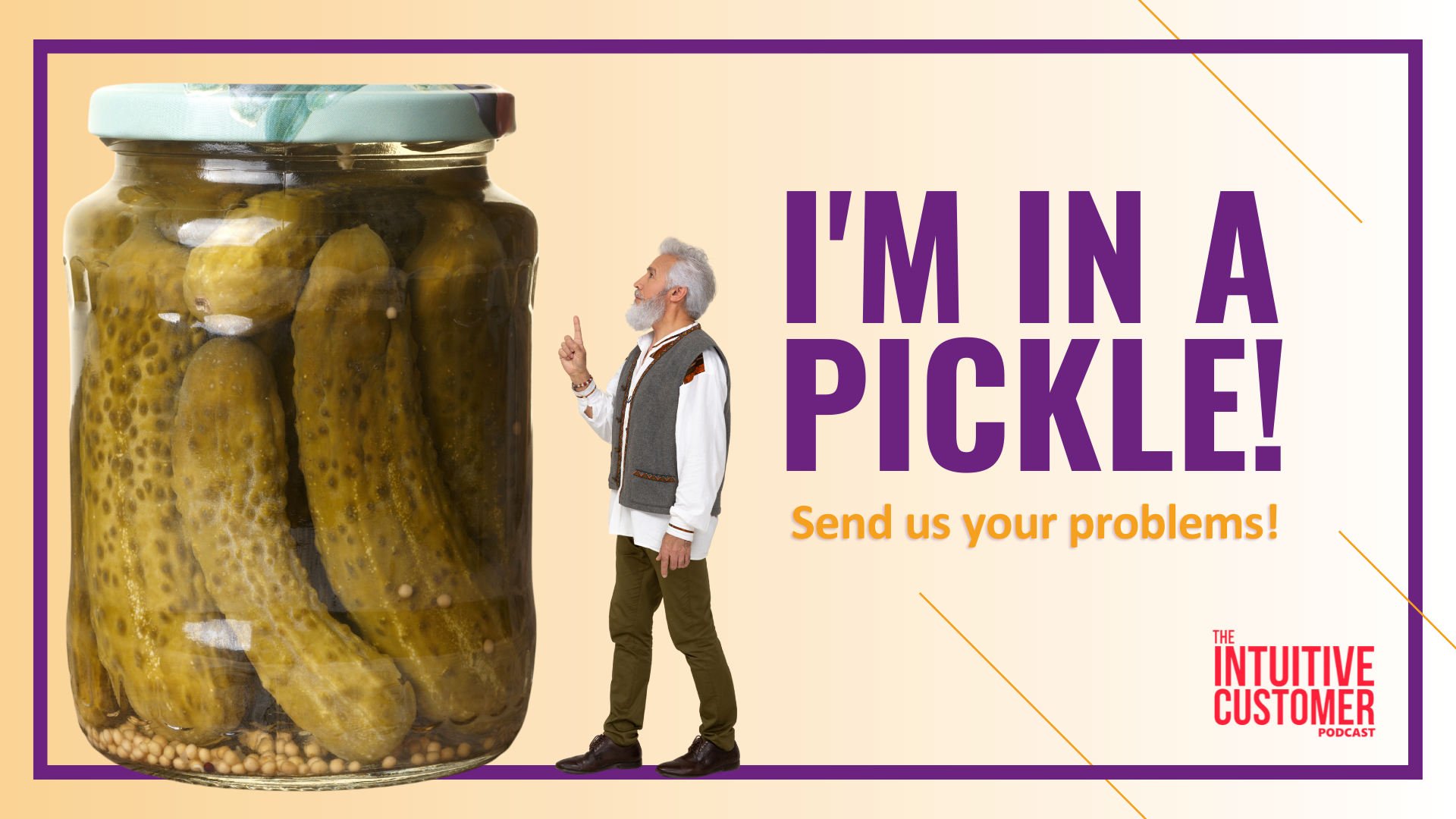On the podcast, we do something called “I’m in a Pickle.” The pickle is a business problem our listeners have that we try to address with the behavioral sciences. For example, we had one recently from a listener Janet, who said that despite getting good comments from customers, they do not give us the top Net Promoter Score (NPS)®. Since I am aware this is a common problem, I thought I would share our advice to Janet with you lot, too.
Janet’s organization has an overall NPS of 68, but its goal is 70. Now, a 68 is an excellent score. However, I understand Janet’s frustration. She explained in her email that they rank from one to five, and many of the customers give them a four, which is still passive, meaning customers like the company but aren’t likely to promote it to their friends and family.
In a recent newsletter, I covered my discussion with the inventor of Net Promoter, Fred Reichheld, about his new book Winning on Purpose. We discovered in our conversation that Reichheld feels the same way. While NPS is beneficial in many ways, people focus too hard on the metric and lose sight of the big picture. NPS is valuable because of its universality, but it shouldn’t be the only thing you measure.
Before we get into that, let’s clear up a practical problem. Using a scale of 1-5 for NPS is incorrect. The correct scale for NPS is 0-10. So, we recommended making that adjustment. Having a larger scale for respondents to choose from is also essential to help you get more detailed about what is happening in your Customer Experience and producing the passive score. Also, it will mean you are measuring the same thing as all the other organizations using NPS, making it easier to compare your organization to others, including competitors.
 It is also important to remember that NPS is not the answer to life, the universe, and everything. NPS is an excellent tool, but other things should supplement it, like the Customer Experience Design. We recommended that Janet’s organization answer the following questions about their experience and how it plays into their customer strategy:
It is also important to remember that NPS is not the answer to life, the universe, and everything. NPS is an excellent tool, but other things should supplement it, like the Customer Experience Design. We recommended that Janet’s organization answer the following questions about their experience and how it plays into their customer strategy:
- What’s the experience that you’re trying to deliver as an organization?
- Which emotions do you want to evoke to get your score up to 70+?
- How do you know those emotions drive value for your organization?
- How do you intend to measure your success with evoking these emotions?
We used these tactics with Maersk Lines, the world’s largest global shipping firm, a few years ago. First, we had them determine what type of experience they wanted to deliver, what emotions it should evoke, and then how we would check our work. In their case, they wanted customers to feel they could trust Maersk, feel as though Maersk cared for them, and be pleased with their service. Then, after that, we found ways to evoke those emotions by changing how their customer process worked. Afterward, we measured their success by asking customers if they felt cared for or pleased. Using this strategy, we were able to move their NPS by 40 points over 30 months.
Therefore, it is essential to get into the details to move the needle on NPS. It would be best for anyone struggling to get the NPS they want to get a lot more granular in your experience assessment. Relying on NPS to tell you what is failing you will only frustrate you. NPS is not a diagnostic designed to show you why you got the score. NPS only scores you based on what you already did.
Another area to consider is the intricacies of customer behavior. There is a significant difference between what customers say and what they mean. There is an even more substantial difference between what customers say and what they ultimately do. Many of you might remember how I always say that when Disney asked what people wanted to eat at the theme park, customers said, “a salad,” but people don’t eat salads at theme parks. So, the point of that story is not to disparage salad eating behavior at theme parks or shame people for wanting to eat junk and later lie about why they did on a survey. The point is customers can’t always tell you what they want when you ask.
In Janet’s case, the company listens to what the customers comments say and likes what they hear. However, the company does not see those comments carry through to the customer behavior they want, which is for customers to recommend them to friends and family. Therefore, the words must not be revealing enough to provide actions for Janet’s organization. Instead, they need to find out what customers mean—or what motivates them to say the good stuff in the first place.
Customer behavior is complicated, particularly regarding providing positive feedback. People leave positive comments for many reasons. First, they might be pleased, which is ideal. However, they might also not be happy, but feel it is impolite to tell you so. As a Brit, I can attest that being polite is a strong motivator for people, even when fuming underneath.
 With these types of motivations working against you, it is essential to up your interpretation game. In other words, you’ve got to get under the skin of what customers say in the comments and discover the real drivers of Net Promoter behavior. For example, our Emotional Signature® Research process revealed what motivated their customers to work with a construction equipment manufacturing company. Now, the world’s biggest construction equipment manufacturer’s perceived wisdom was that customers wanted a reasonable price for reliable machinery with plenty of parts available for replacement and a high resale value. That would be enough for them to recommend the company to others. While those things did provide value, we discovered through our research that what drove NPS behavior was that the construction equipment manufacturer listened to customers and cared for customers as a person. Not exactly what you would expect from a construction market customer, but there it was.
With these types of motivations working against you, it is essential to up your interpretation game. In other words, you’ve got to get under the skin of what customers say in the comments and discover the real drivers of Net Promoter behavior. For example, our Emotional Signature® Research process revealed what motivated their customers to work with a construction equipment manufacturing company. Now, the world’s biggest construction equipment manufacturer’s perceived wisdom was that customers wanted a reasonable price for reliable machinery with plenty of parts available for replacement and a high resale value. That would be enough for them to recommend the company to others. While those things did provide value, we discovered through our research that what drove NPS behavior was that the construction equipment manufacturer listened to customers and cared for customers as a person. Not exactly what you would expect from a construction market customer, but there it was.
In Janet’s case, we advised her to discover what emotions drive value and improve her customers’ NPS. Then, Janet’s company should execute its experience against those goals. In other words, read the comments and read between the comments’ lines to ascertain intent. Look for hidden customer messages they might have missed the first time around. Also, if they have the budget, do actual research on what drives value for your organization.
Another essential part of your Customer Strategy is to be specific about what feedback you want. For example, if you ask, “What do you think of our company?” or “How likely are you to recommend our company?” and that’s it, you don’t have any specific area feedback. So, when those answers reflect a downward trend about your company and a decrease in NPS, then you won’t know why. Instead, I recommend that you get more tactical with your questions rather than broad. Then, you have area-specific feedback that can help you determine where your opportunities lie. You might also break down the customer journey into different sections to see if there is an opportunity in any of the separate parts of the overall journey.

Measuring your performance in parts will help you fix the whole experience. Otherwise, you don’t know where you need to fix things. For example, when working with a home improvement company, we used this section approach. We had the pre-sales section, the sales, the installation, and the post-installation. Using this strategy, we could see that some parts, like pre-sales and sales, were getting high NPS scores, but installation wasn’t. Using this tactical approach, our client could see that the opportunity to improve their overall NPS was in the installation part of the customer journey. Without this insight, they might have decided to fix the wrong things.
So, to summarize our listener Janet’s problem with her NPS performance, there are a few things to remember:
- Using the 1-5 scale instead of the 0-10 scale required for NPS could be creating a lower performance in NPS than the company has. Changing to the proper scale is essential.
- Asking broad questions allows customers to avoid getting specific in their feedback. Janet’s company should get more granular with their customer strategy and ask many questions about how customers feel in particular moments to determine their experience opportunities.
- Taking what customers say as gospel could be misleading. Discover what drives value by undertaking research (like Emotional Signature) and don’t rely on customer comments to determine it.
- Having only NPS as a metric is excellent, but having more measurements in place is better. Janet’s company should think about assessing things from both a strategic and tactical perspective.
Another thing I would leave you with is the idea that some people always give the top ranking, and some people never do. It is an individual difference between the personalities of individuals. In some cases, positive people never give low marks below the mid-point, even when they are very dissatisfied. Therefore, getting more feedback is better than less because it allows you to see a complete picture of your performance. The smaller the response, the more influence these individual preferences for ranking things have on the outcome.
Also, remember me when you send out a survey. I get a request for a survey response every time I fly with Delta, which is a lot. However, the only time I fill it out is when I have a problem. Could the same be true with your survey frequency strategy?
Overall, when it comes to NPS, you should use it to see if it’s going up or going down. Suppose it’s going up. Then, great. Keep doing what you are doing. However, if it’s going down, you need more information. Get clever about it by digging into what drives value and how your customers feel during their experience. The greatest thing about NPS is it is simple to understand and easy to compare across companies. However, its simplicity means that it isn’t the answer to everything—and you shouldn’t expect it to be. Instead, focus on the bigger picture that the NPS is reporting. Then, like Janet, the only pickle on your life will be the one on your burger when you are eating at Disneyland.
Do you have a business problem pickle that you would like us to solve? We’d love to hear it. Please tell us about it by clicking here.
There you have it. No promotions, no gimmicks, just good information.
Think reading is for chumps? Try my podcast, The Intuitive Customer instead. We explore the many reasons why customers do what they do—and what you should do about it. Subscribe today right here.



